15 Best Native Plants for Lafayette, LA
BY MELANIE JOSEPH | MAY 25TH, 2023 | LAFAYETTE, LAWN CARE, LOUISIANAKnown for scrumptious Creole and Cajun food, Lafayette prides itself on its unique culture and natural beauty. It’s home to an array of flora and fauna, including many native plants that thrive in the region’s hot, humid summers. From wildflowers and shrubs to vines and trees, these plants offer a host of benefits to homeowners and the environment alike, including:
- Adaptability: Naturally adapted to the local climate and soil conditions, native plants are more resilient and easier to care for than non-native species.
- Sustainability: Native plants require less water and fertilizer, reducing the environmental impact of your landscaping.
- Habitat: Native plants provide habitat and food for local wildlife, including birds, butterflies, and other beneficial insects.
- Beauty: From the striking blooms of the Louisiana iris to the stately presence of the bald cypress, native plants offer a diverse array of colors, textures, and forms.
Explore the 15 best native plants for Lafayette, and discover how you can incorporate these beautiful and beneficial species into your own backyard.
In this article, we’ll cover:
- 15 Best Native Plants for Your Lafayette Yard
- How to Choose Native Plants for Your Lafayette Landscape
- FAQ About Native Lafayette Plants
- Where to Find Native Plants in Lafayette
15 Best Native Plants for Your Lafayette Yard
Here are 15 of the best native plants for Lafayette, including shrubs, trees, wildflowers, and groundcovers.
1. American Beautyberry (Callicarpa Americana)
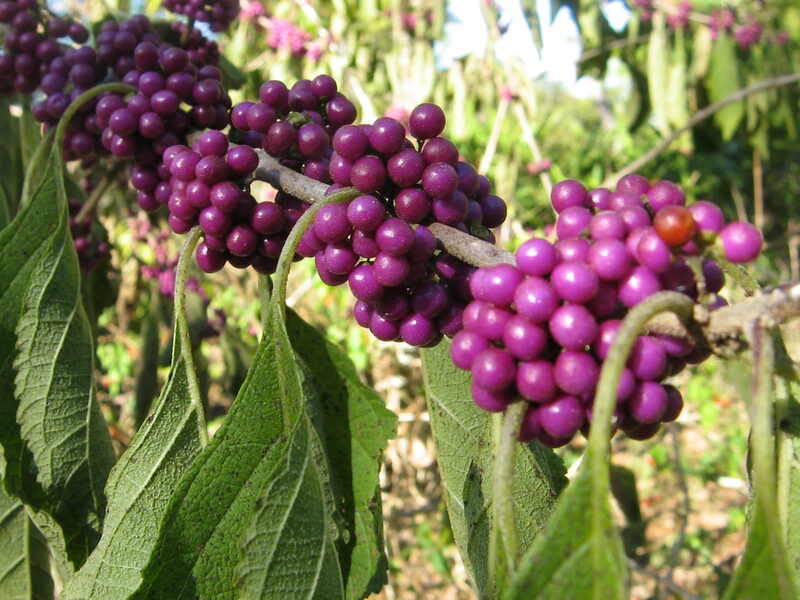
Photo Credit: Korall / Wikimedia Commons / CC BY-SA 3.0
A shrub native to the southeastern United States, American beautyberry can be found growing naturally along the edges of fields and in wooded areas. It is a tough and adaptable plant that can thrive in various soil types and light conditions.
This perennial plant is known for its clusters of bright purple berries that are produced in late summer and fall, which are not only beautiful to look at but also serve as an important food source for birds, raccoons, whitetail deer, and opossums.
In addition to its attractive berries, American beautyberry produces small, pale pink flowers in the spring and early summer that are a valuable source of nectar for bees and butterflies. It is also a larval host plant for the beautiful royal walnut moth.
Growth habit: Shrub
USDA Hardiness Zone: 6b-11
Mature size: 3-8 feet tall, 4-8 feet wide
Duration: Perennial
Foliage: Deciduous
Sunlight needs: Full sun to partial shade – requires a minimum of four hours of sunlight per day
Soil preferences: Prefers organic, fertile, loam soil but can still grow in most soil types
Water needs: Low – around 1 inch of water per week, but give it deep, slow watering during drought and extreme dry spells
Potential hazards: Non-toxic – but avoid eating its berries as they may cause discomfort, such as vomiting
2. Bald Cypress (Taxodium distichum)
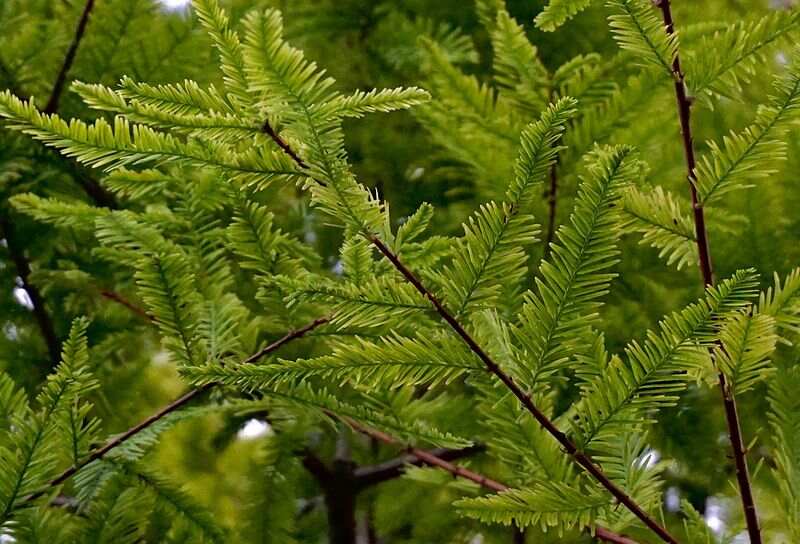
Photo Credit: Treeworld Wholesale / Wikimedia Commons / CC BY 2.0
Highly valued for its aesthetic appeal and ecological benefits, the bald cypress has a broad, pyramidal shape and needle-like leaves that turn a striking rust color in the fall. It’s commonly found in swamps, bayous, and floodplains throughout the Lafayette area, but you also can see it in various parks and gardens, such as Girard Park and the University of Louisiana at Lafayette’s Cypress Lake.
As a native species, this deciduous tree is well adapted to the hot and humid Louisiana climate, and requires little maintenance once established. Its cones and seeds are a food source for various wildlife, and its roots help stabilize soil and prevent erosion.
In addition, bald cypress is tolerant of wet soil conditions and can help absorb excess water during heavy rains. It’s slightly to moderately resistant to challenges, such as salt, fire, deer, and standing water.
Growth habit: Tree
USDA Hardiness Zone: 4-10
Mature size: 50-70 feet tall, 20-30 feet wide
Duration: Perennial
Foliage: Deciduous
Sunlight needs: Partial shade to full sun – thrives in areas with at least six hours of sun exposure per day
Soil preferences: Moist, well-drained, fertile, acidic, clay, or loamy soil
Water needs: Low – needs at least 1 inch of water per week, and the soil must be kept evenly moist
Potential hazards: Non-toxic
3. Black-Eyed Susan (Rudbeckia hirta)
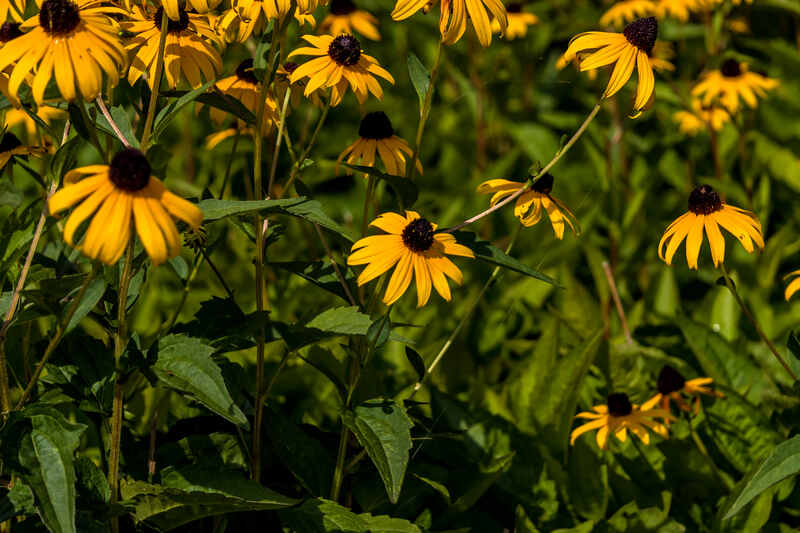
Photo Credit: Michel Rathwell / Wikimedia Commons / CC BY 2.0
A hardy perennial that thrives in full sun and well-drained soil, black-eyed Susan can add a pop of color to your landscape. It’s a drought-tolerant plant that blooms from early summer to early fall in the Gulf Coast region, producing bright yellow-orange flowers with dark centers that attract bees, butterflies, and other pollinators.
From New Orleans to Baton Rouge to Lafayette, you’ll commonly find black-eyed Susan planted in meadows, prairies, and along roadsides. You can plant it as a border or backdrop for other plants in your garden or flower bed, along fences or walls, and in naturalized areas. Remember to deadhead the flowers after they bloom to promote further blooming throughout the season.
Growth habit: Wildflower
USDA Hardiness Zone: 3-9
Mature size: 2-4 feet
Duration: Short-lived perennial, annual, or biennial (depending on growing conditions)
Foliage: Deciduous
Sunlight needs: Full sun to partial shade – it needs at least six hours of sun exposure each day
Soil preferences: Well-drained, fertile, acidic, loamy, sandy soil
Water needs: Low
Potential hazards: Non-toxic to humans and pets, but may cause allergic skin reactions and asthma attacks
4. Crimson-Eyed Rose Mallow (Hibiscus moscheutos)
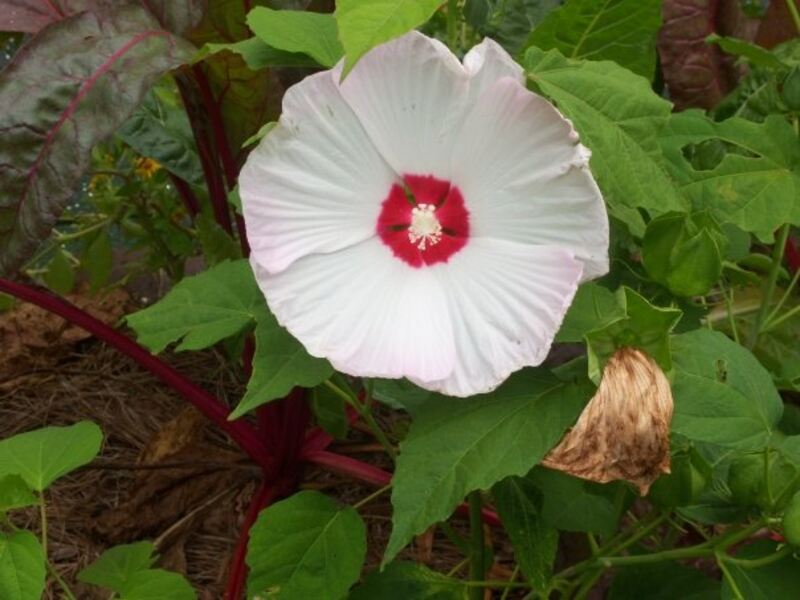
Photo Credit: Calvin Webster / Flickr / CC BY-SA 2.0
Also known as swamp rose mallow, crimson-eyed rose mallow is a perennial plant native to Louisiana and other southeastern states. The plant produces large, showy flowers in shades of pink, white, and red, measuring up to 12 inches in diameter. It blooms from summer to fall, attracting pollinators like bees and hummingbirds.
This plant is perfect for rain gardens, naturalized areas, and other wet or low-lying spots in the yard. To encourage healthy growth and maximum flowering, fertilize crimson-eyed rose mallow with a slow-release fertilizer in early spring, and keep the soil moist throughout the growing season.
As a larval host to several moths and butterflies, including the rose mallow moth, pearly wood nymph, and common checkered skipper, the crimson-eyed rose mallow is an integral part of the local ecosystem. Additionally, the plant’s deep roots help to stabilize soil and prevent erosion, making it an ideal choice for wetland restoration projects.
Growth habit: Wildflower
USDA Hardiness Zone: 4a-9b
Mature size: 2-6 feet tall, 2-5 feet wide
Duration: Perennial
Foliage: Deciduous
Sunlight needs: Partial shade to full sun
Soil preferences: Moist, fertile, slightly acidic, sandy, or loamy soil
Water needs: High – water regularly, especially during hot weather
Potential hazards: Non-toxic to both humans and pets
5. Coral Honeysuckle (Lonicera sempervirens)
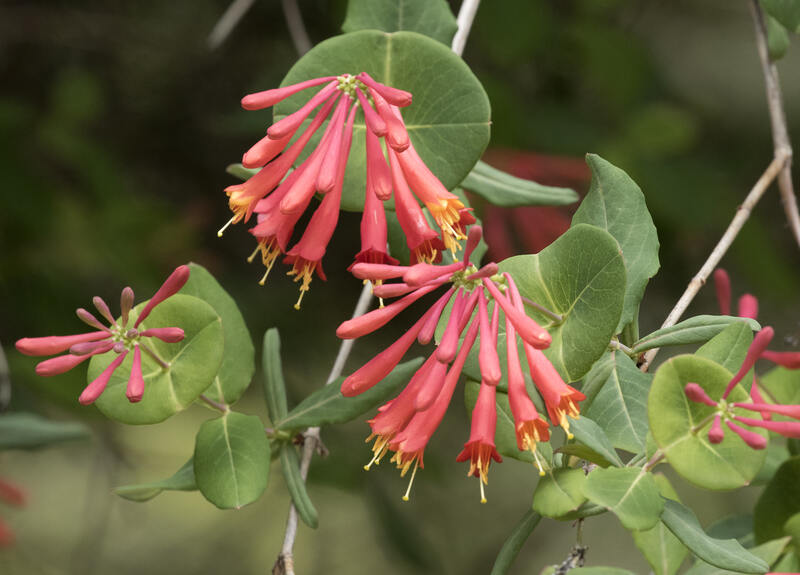
Photo Credit: Zeynel Cebeci / Wikimedia Commons / CC BY-SA 4.0
Native to the southeastern United States, coral honeysuckle is commonly found growing in woodlands, along roadsides, fence rows, and trellises. It’s sometimes called trumpet honeysuckle because of the bright coral-red tubular flowers that adorn it from spring to early fall.
A larval host to the spring azure butterfly, this perennial vine attracts pollinators and wildlife, including hummingbirds, bees, and other beneficial insects. In addition to its beauty, coral honeysuckle is relatively easy to care for. Although, it needs regular watering, especially during dry spells.
An excellent groundcover, coral honeysuckle can be mixed with other native plants to create a beautiful and diverse landscape. And if you want to make it more beautiful in the garden, prune it to maintain its shape and size. Deadheading spent flowers also can encourage additional blooming throughout the growing season.
Growth habit: Vine
USDA Hardiness Zone: 4-10
Mature size: 3-20 feet tall, 3-6 feet wide
Duration: Perennial
Foliage: Semi-evergreen to evergreen
Sunlight needs: Prefers full sun but can still grow in partial shade
Soil preferences: Grows in most soil types but thrives in well-drained, fertile, slightly acidic, loamy soil
Water needs: Moderate
Potential hazards: While birds eat its berries, they are toxic to humans and pets
6. Flowering Dogwood (Cornus florida)
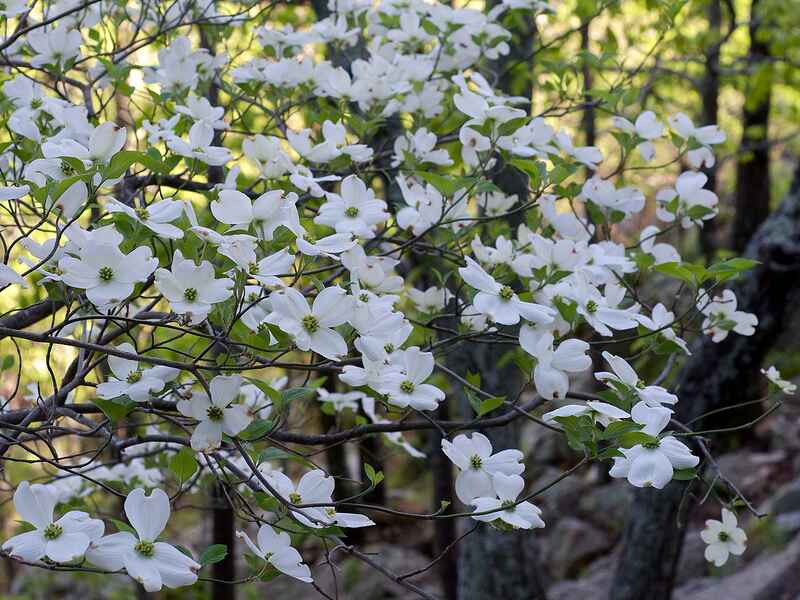
Photo Credit: Eric Hunt / Wikimedia Commons / CC BY-SA 4.0
Known for its striking pink or white blooms that appear in the spring, flowering dogwood can add beauty and elegance to your garden. In addition to its aesthetic appeal, this perennial tree serves a crucial ecological role in supporting local wildlife. Its nectar-rich flowers attract various pollinators, while its leaves serve as a host for the larvae of certain moth species.
Whether planted as a specimen tree or as part of a larger landscape design, flowering dogwood is a beautiful and valuable addition to any Lafayette homeowner’s yard. And if you want it to thrive in your garden or landscape, provide it with proper care. Prune it regularly to promote growth and maintain its shape.
Growth habit: Tree
USDA Hardiness Zone: 5-9
Mature size: 20-65 feet tall
Duration: Perennial
Foliage: Deciduous
Sunlight needs: Part shade to full shade
Soil preferences: Dry to moist, well-drained, acidic soil
Water needs: Low
Potential hazards: The fruit is poisonous to humans
7. Fragrant Goldenrod (Solidago chilensis)
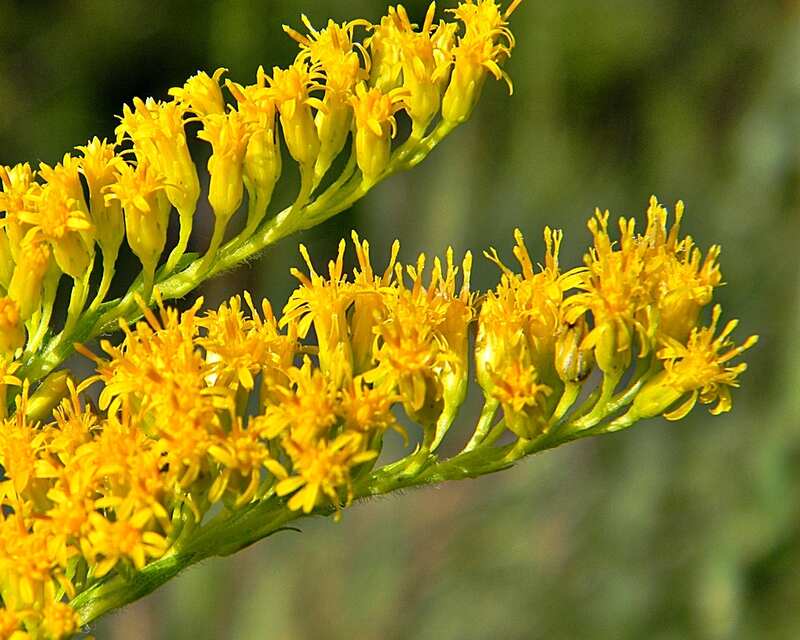
Photo Credit: Bob Peterson / Wikimedia Commons / CC BY-SA 2.0
Also known as sweet goldenrod, this perennial plant boasts beautiful clusters of yellow flowers that bloom in late summer and early fall. It’s often planted in meadows, prairies, and open woodlands but can thrive even in home gardens.
Besides attracting pollinators, including butterflies, bees, and wasps, fragrant goldenrod also serves as a host plant for several moth species, including the goldenrod gall moth.
You can plant it in groups for a bold statement or mix it with other native plants for a more diverse landscape. It has a pleasant fragrance that can fill the air around it. And like bluestem goldenrod, this wildflower is also moderately deer-resistant.
Growth habit: Wildflower
USDA Hardiness Zone: 4a-9b
Mature size: 1-2 feet tall
Duration: Perennial
Foliage: Deciduous
Sunlight needs: Partial shade to full sun
Soil preferences: Moist, well-drained, clay, or loamy soil
Water needs: Moderate
Potential hazards: While it has therapeutic properties, certain people, like those with medical conditions, should avoid ingesting any of its parts.
8. Louisiana Iris (Iris hexagona)
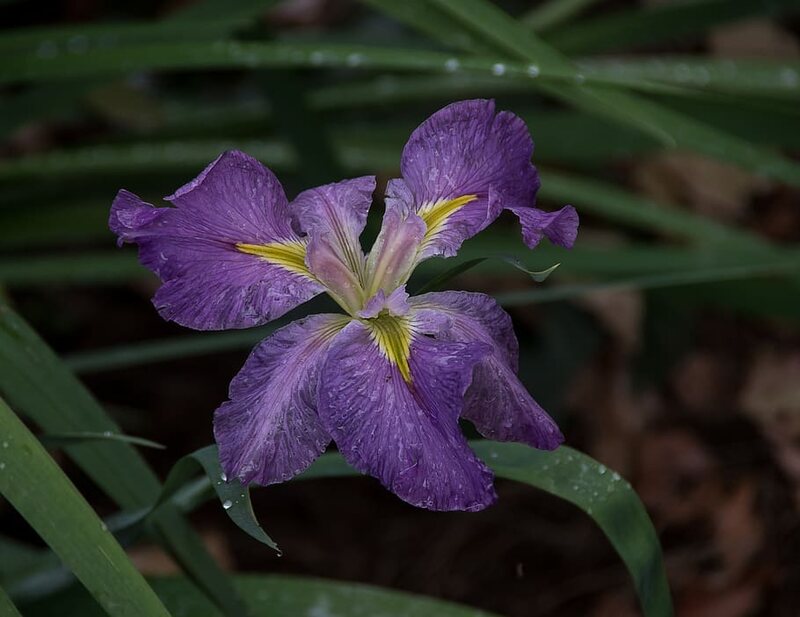
Photo Credit: Pxfuel
Well-suited to the humid and rainy climate of the Acadiana region, Louisiana iris is a rare plant found growing in the wetlands and along the edges of ponds, lakes, waterways, and other bodies of water throughout Lafayette. It blooms in a range of colors, including purple, blue, yellow, and white, and typically flowers in the spring.
Various insects, pollinators, and wildlife rely on this plant. For example, it is the host plant for the Louisiana iris moth, which is found in the southern United States.
Also known as dixie iris, this plant is a favorite among gardeners due to its hardiness and ability to thrive even in standing water. Lawn enthusiasts can use this native wildflower in mass plantings or as a backdrop for other plants in their gardens.
Growth habit: Wildflower
USDA Hardiness Zone: 4-9
Mature size: 1-3 feet tall
Duration: Perennial
Foliage: Deciduous
Sunlight needs: Full sun
Soil preferences: Moist, fertile, acidic soil
Water needs: Low – needs at least 1 inch of water per week during its growing season
Potential hazards: Toxic to pets, especially cats, dogs, and horses
9. Parsley Hawthorn (Crataegus marshallii)
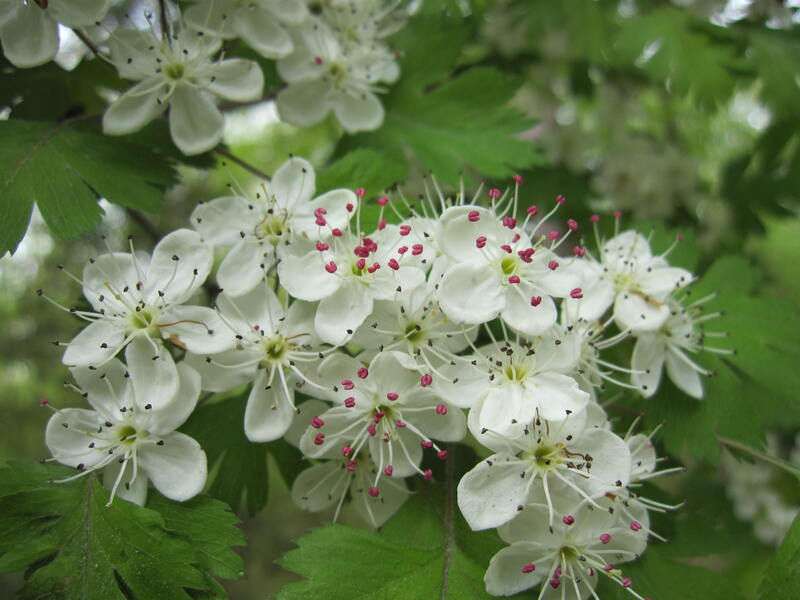
Photo Credit: Chris M Morris / Flickr / CC BY 2.0
A small tree ideal for little gardens or as an understory tree in larger landscapes, parsley hawthorn is commonly found growing in the woods and along streams and rivers throughout the southeastern United States.
As a larval host plant for the gray hairstreak butterfly, this perennial tree serves as an essential part of the local ecosystem. The tree blooms in the spring, producing lovely white flowers that attract other pollinators, including bees, hummingbirds, and other butterflies. In the fall, the tree’s red berries provide a food source for birds and other wildlife.
You can enhance the tree’s beauty by planting it in groupings, adding understory plantings beneath it, or underplanting it with other shade-loving plants such as ferns or hostas. When properly cared for, parsley hawthorn can be a stunning addition to any landscape, providing year-round interest and supporting biodiversity.
Growth habit: Tree
USDA Hardiness Zone: 7-9
Mature size: Up to 25 feet tall and 15 feet wide
Duration: Perennial
Foliage: Deciduous
Sunlight needs: Full sun to partial shade – can survive even in deep shade
Soil preferences: Well-drained, moist, sandy, or loamy soil
Water needs: Moderate – needs infrequent but deep watering
Potential hazards: Non-toxic, but the seeds can be poisonous if ingested, and its thorns can cause injuries
10. Purple Coneflower (Echinacea purpurea)
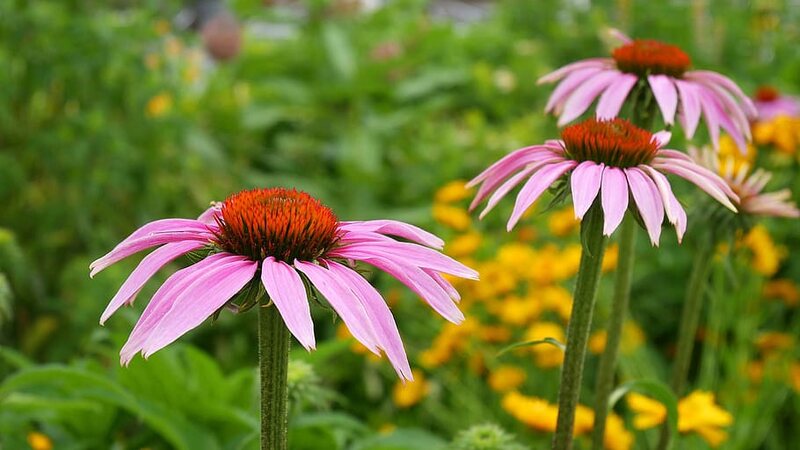
Photo Credit: Wallpaperflare
Native to the eastern and central US, purple coneflower grows wild in prairies, meadows, and open woods. This hardy perennial is easy to grow and can add a beautiful burst of color to any garden. Blooming from late spring to mid-summer, it’s a favorite of butterflies and bees, making it perfect for gardeners looking to attract pollinators to their yards.
Remember to deadhead the flowers as they fade to encourage more blooms. You also can pair this wildflower with companion plants, such as black-eyed Susans or ear-leaved tickseed, to create a stunning display of color and attract even more pollinators. Note, though, that this deciduous plant has a medium flammability rating, so don’t place it too close to your home.
Growth habit: Wildflower
USDA Hardiness Zone: 4-9
Mature size: 3-4 feet tall
Duration: Perennial
Foliage: Deciduous
Sunlight needs: Partial shade to full sun
Soil preferences: Well-drained, moist to occasionally dry, fertile soil
Water needs: Moderate
Potential hazards: Non-toxic, but may cause discomfort when ingested in large amounts
11. Red Maple (Acer rubrum)
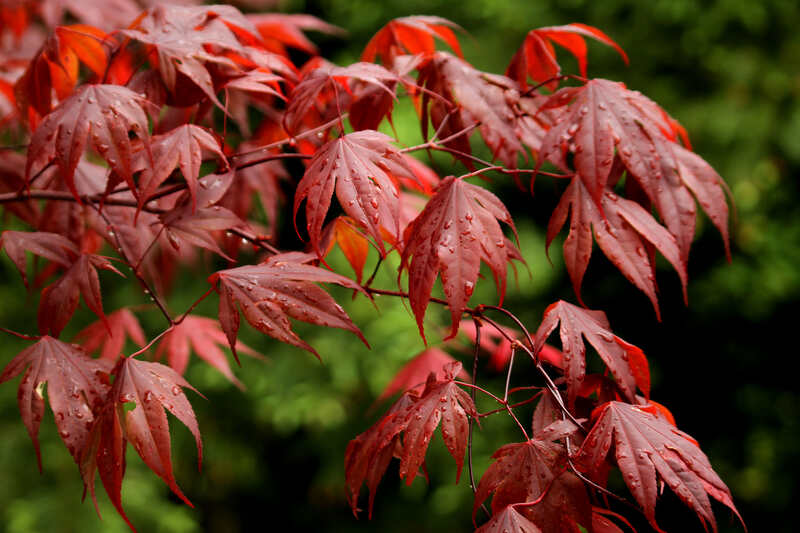
Photo Credit: Heng Wang / Wikimedia Commons / CC BY-SA 3.0
Red maple is a beautiful and versatile tree that can thrive in various soil types and growing conditions. This deciduous tree is native to Louisiana and can be found throughout Lafayette in a range of habitats – from swamps to uplands. In the fall, its leaves turn a brilliant shade of red, making it a stunning addition to any landscape.
An essential resource for pollinators and wildlife, the tree produces small, red flowers in the early spring that attract bees and other insects. These flowers give way to distinctive winged seeds that provide food for birds and small mammals. Additionally, the red maple is a larval host to several species of moths and butterflies, including the rosy maple moth.
If you want to make your red maple tree more beautiful, give it enough water and nutrients. The tree prefers moist, well-drained soil and can benefit from regular fertilization. Also, prune it regularly to maintain its shape and prevent the growth of weak branches that may break during hurricanes and strong winds.
Growth habit: Tree
USDA Hardiness Zone: 3-9
Mature size: 40-60 feet tall and 25-45 feet wide
Duration: Perennial
Foliage: Deciduous
Sunlight needs: Partial shade to full sun
Soil preferences: Moist to dry, well-drained, slightly acidic soil
Water needs: High
Potential hazards: Toxic, especially the wilted and dried leaves
12. Southern Indian Azalea (Rhododendron indicum)
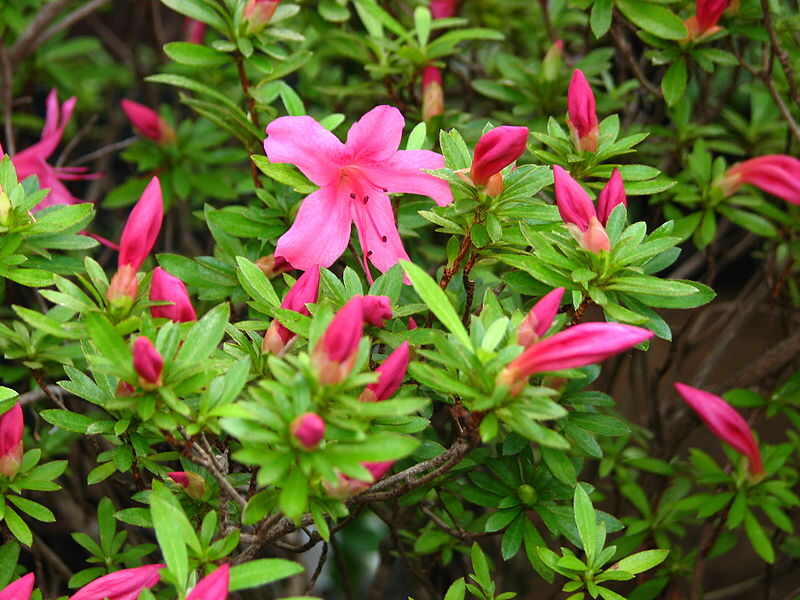
Photo Credit: Andrey Korzun / Wikimedia Commons / CC BY-SA 3.0
When azaleas bloom in the Deep South, it signals the start of spring. For this reason, the Southern Indian azalea has been named the official city flower of Lafayette. With its showy blooms of pink, purple, white, and red, this azalea is a popular choice for adding color and beauty to any yard.
Also known as the Southern Indica azalea, this beloved flowering shrub can be found in many gardens and landscapes throughout Lafayette. And if you want to bask in the beauty of their blooms along with other azaleas, you can simply stroll around the city’s historic azalea trail.
As a larval host plant, Southern Indian azaleas provide a home for the larvae of the Eastern tiger swallowtail butterfly. They are typically planted in early spring and bloom from late March to early May, attracting pollinators such as bees, butterflies, and hummingbirds with their sweet nectar.
Pruning after the blooms have faded will help encourage new growth and maintain a healthy shape. These plants are often used as foundation plants, specimen plants, or in mass plantings for a dramatic effect.
Growth habit: Shrub
USDA Hardiness Zone: 8-10
Mature size: 2-3 feet tall and 2-3 feet wide
Duration: Perennial
Foliage: Semi-evergreen
Sunlight needs: Partial shade
Soil preferences: Well-drained, moist, rich, slightly acidic, loamy (silt) soil
Water needs: Low – requires at least 1 inch of water per week during dry spells
Potential hazards: Highly toxic – all parts of the plant are poisonous to both humans and animals
13. Southern Magnolia (Magnolia grandiflora)
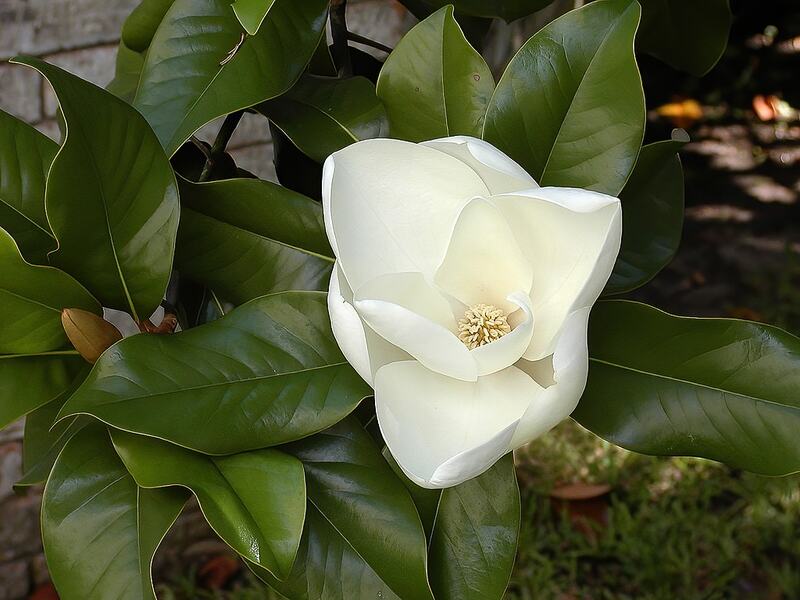
Photo Credit: Jim Evans / Wikimedia Commons / CC BY-SA 4.0
With its fragrant, creamy white flowers that bloom from spring to summer, the Southern magnolia is Louisiana’s state flower. Native to the southeastern United States, it’s often planted as ornamental trees in yards, parks, and public gardens, including the Acadiana Park Nature Station.
Known for its large, glossy leaves, this native tree grows wild in forests or near water and provides a habitat for various wildlife, including birds and insects. Beetles pollinate the tree’s flowers, while birds and small mammals eat its fruits.
You can make it more beautiful in your native garden by providing proper care, such as regular fertilizing and mulching. Pruning Southern magnolia can help shape it and encourage healthy growth. Planting complementary understory plants such as ferns and shade-loving perennials can help create a beautiful and healthy ecosystem around the tree.
Growth habit: Tree
USDA Hardiness Zone: 6-10
Mature size: 60-80 feet tall and 30-50 feet wide
Duration: Perennial
Foliage: Evergreen
Sunlight needs: Partial shade to full sun
Soil preferences: Well-drained, moist, fertile soil
Water needs: Low – may need supplemental watering during extended dry spells
Potential hazards: Non-toxic to both humans and animals
14. Texas Star Hibiscus (Hibiscus coccineus)
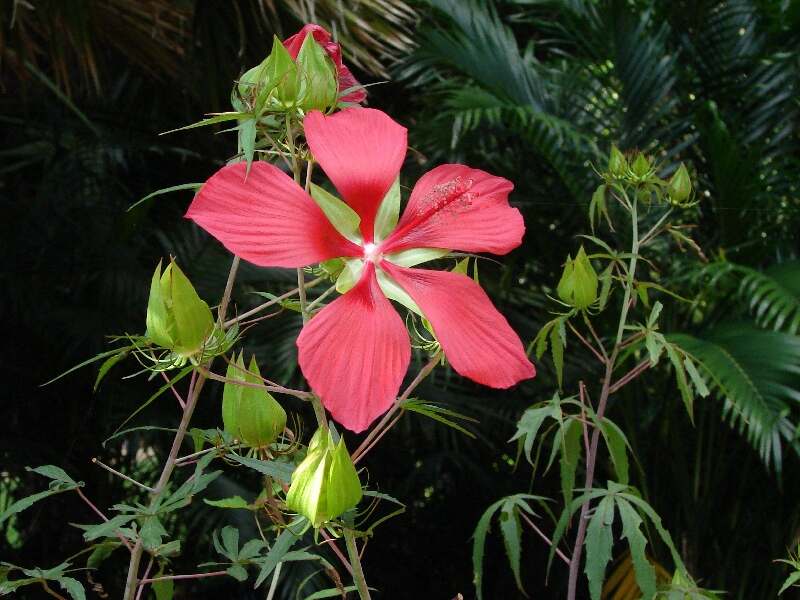
Photo Credit: Tatters / Flickr / CC BY 2.0
Also known as the scarlet rose mallow, the Texas star hibiscus has large, showy, bright red flowers with prominent stamens and a dark maroon center. It typically blooms from late spring to early fall and is a great choice for gardeners looking to attract hummingbirds, butterflies, and bees, as it is a favorite nectar source for these pollinators.
In Lafayette, you can find this salt-tolerant wildflower planted in many gardens and public spaces, including the Hilliard University Art Museum and the Lafayette Science Museum. Its natural habitat is along the edges of swamps, bayous, and rivers, but it can thrive in a range of soil types and growing conditions.
Growth habit: Wildflower
USDA Hardiness Zone: 5-9
Mature size: 6-8 feet tall
Duration: Perennial
Foliage: Deciduous
Sunlight needs: Full sun to partial shade
Soil preferences: Prefers moist soil but grows well in most soil types
Water needs: High – needs 1-3 inches of water per week, even more during dry spells
Potential hazards: Non-toxic
15. Yaupon Holly (Ilex vomitoria)
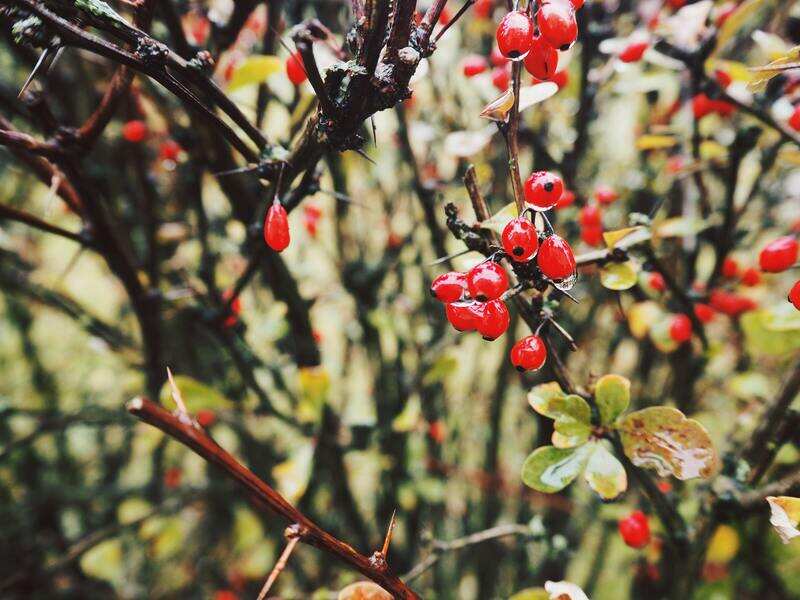
Photo Credit: Pxhere
Commonly found in the southeastern United States, yaupon holly is a hardy and adaptable plant that can thrive in various soil conditions. Its natural habitat is along coastal areas, in sandy soils or swamps, maritime woods, and limestone uplands. This evergreen plant is resistant to drought, deer, salt, and wind.
As a larval host to the Henry’s Elfin butterfly, yaupon holly plays an important role in supporting local ecosystems. The plant blooms in spring and produces small, inconspicuous flowers that are a valuable nectar source for bees and other pollinators. The berries that follow are also an important food source for birds.
Additionally, you can prune it to create an attractive shape or incorporate it into a mixed border with other plants that complement its glossy green foliage. It also responds well to regular fertilization and watering, so giving it the right nutrients and moisture can help it thrive in the landscape.
Growth habit: Shrub, small tree
USDA Hardiness Zone: 7-9
Mature size: 10-20 feet tall
Duration: Perennial
Foliage: Evergreen
Sunlight needs: Full sun to partial shade
Soil preferences: Well-drained, moist, rich, loamy soil
Water needs: Low
Potential hazards: Toxic – its berries can be poisonous when eaten
How to Choose Native Plants for Your Lafayette Landscape
Lafayette is home to an array of stunning native plants that can add color and character to any landscape. But the task of choosing the right plants for your specific yard can be tedious.
The first step is to consider the USDA hardiness zone, which for Lafayette is primarily 9a. The average minimum temperature in the city is 20 degrees Fahrenheit. This means plants that thrive in warm, humid climates can flourish in your yard.
Since native plants have already evolved to thrive in your local ecosystem, they can provide multiple benefits to your yard. They support the local pollinators and wildlife and can even help mitigate local environmental issues such as soil erosion. But you must check if they are well-suited to your specific yard’s conditions, such as soil type, sunlight exposure, and moisture levels.
You can seek guidance from LSU’s local cooperative extension or soil testing lab to determine your soil type and condition. Also, consider water usage and conservation. Many native plants are drought-tolerant and can withstand hot summers, but you may still need to add mulch or compost to retain soil moisture and reduce the need for watering.
FAQ About Native Lafayette Plants
Lafayette is home to various public gardens and natural areas that showcase the region’s stunning plant life. One popular destination is the Lafayette Science Museum Native Garden, which features over 150 species of native plants. The garden is designed to provide a hands-on educational experience for visitors and serves as a model for sustainable landscaping practices.
Another must-see spot is the University of Louisiana at Lafayette’s Native Plant Garden. This garden showcases over 100 species of native plants and serves as a living laboratory for students studying horticulture, ecology, and biology.
If you want a more natural setting, you can head to the nearby Acadiana Park Nature Station. Here, you’ll find a variety of native plant species, including swamp milkweed, cardinal flower, and beautyberry. The nature station also offers guided hikes and educational programs throughout the year.
Finally, don’t forget to check out the city’s numerous parks and green spaces, many of which feature native plantings. From Girard Park to Moncus Park, you will find stunning examples of Lafayette’s diverse plant life just a short drive from your doorstep.
Some excellent choices for backyard buffers in Lafayette include Southern magnolia, yaupon holly, and Texas star hibiscus. These plants not only provide a natural screen but also attract wildlife to your yard and support the local ecosystem. Consider using a mix of native grasses to create a diverse buffer that provides year-round interest and beauty.
Lafayette is located in a region with a rich history of agriculture and farming, so it’s no surprise that the city’s soil is ideal for many types of plants. The soil is typically well-draining, sandy loam, with a pH range of 5.0 to 7.0.
The sandy texture of the soil provides excellent drainage, making it less prone to waterlogging, which is important during the rainy season. It also allows for good aeration and root development, essential for healthy plant growth.
While sandy soil is generally easy to work with, it can be low in nutrients and organic matter. To help plants thrive, homeowners may consider adding compost or other organic materials to their soil.
When it comes to selecting turfgrass to complement your native plants, you must consider several factors, such as climate, soil type, and maintenance requirements. Warm-season grasses like bermudagrass, Zoysiagrass, and St. Augustinegrass are well-suited to the region’s hot and humid summers, making them a popular choice for lawns.
Bermudagrass is known for its durability and drought tolerance, while Zoysiagrass is favored for its low maintenance and tolerance to foot traffic. St. Augustinegrass is a popular choice for its lush appearance and shade tolerance, making it a good option for areas with partial shade.
Where to Find Native Plants in Lafayette
Lafayette homeowners looking to add native plants to their gardens have a wealth of resources at their disposal. The region’s warm climate and well-draining soil make it an ideal environment for many native species, which can help support the local ecosystem and create a beautiful, low-maintenance landscape.
One excellent place to start your search for native plants is the Louisiana Native Plant Society. This organization offers a wealth of information on native plants, including their growing conditions and where to find them.
When choosing plants for your garden, consider factors like soil type, exposure to sunlight, and water availability. Native plants often thrive with minimal maintenance, but you’ll still need to pick the right plants for your landscape.
Another option for finding native plants is to attend a local plant sale or nursery event. Many nurseries and botanical gardens host sales throughout the year, and these can be an excellent opportunity to find rare or hard-to-find species.
If you don’t have enough time to design and maintain an eco-friendly garden or aren’t confident in your gardening ability, a Lafayette landscaping pro can assist you in creating and preserving a lovely and sustainable garden.
Main Image Credit: Flowering dogwood / Pxfuel